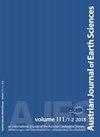The Alland earthquake sequence in Eastern Austria: Shedding light on tectonic stress geometry in a key area of seismic hazard
IF 1.1
4区 地球科学
Q2 Earth and Planetary Sciences
引用次数: 3
Abstract
Abstract We present our results on the fault geometry of the Alland earthquake sequence in eastern Austria (Eastern Alps) and discuss its implications for the regional stress regime and active tectonics. The series contains 71 known events with local magnitudes 0.1 ≤ ML ≤ 4.2 that occurred in between 2016 and 2017. We locate the earthquakes in a regional 3D velocity model to find absolute locations. These locations are then refined by relocating all events relative to each other using a double-difference approach, based on relative travel times measured from waveform cross-correlation and catalogue data. We also invert for the moment tensor of the ML = 4.2 mainshock by fitting synthetic waveforms to the recorded seismo-grams using a combination of the L1- and L2-norms of the waveform differences. Direct comparison of waveforms of the largest events in the sequence suggests that all of them ruptured with very similar mechanisms. We find that the sequence ruptured a reverse fault, that is dipping with ~30° towards ~north-northeast (NNE) at 6–7 km depth. This is supported by both the hypocentres and the mainshock source mechanism. The fault is most likely located in the buried basement of the Bohemian massif, the “Bohemian Spur”. This (reverse) fault has a nearly perpendicular orientation to the normal-fault structures of the Vienna Basin Transfer Fault System further east at a shallower depth, indicating a lateral stress decoupling that can also act as a vertical stress decoupling in some places. In the west, earthquakes (at a larger depth within the upper crust) show compressive stresses, whereas the Vienna Basin to the east shows extensional (normal-faulting) stress. This provides insight into the regional stress field and its spatial variation, and it helps to better understand earthquakes in the area, including the “1590 Ried am Riederberg” earthquake.奥地利东部的奥兰地震序列:揭示地震危险关键区域的构造应力几何
摘要本文介绍了奥地利东部(东阿尔卑斯山脉)Alland地震序列的断层几何形状,并讨论了其对区域应力状态和活动构造的影响。该系列包含2016年至2017年间发生的71次已知局地震级为0.1≤ML≤4.2的地震事件。我们将地震定位在一个区域三维速度模型中,以找到绝对位置。然后,根据从波形相互关联和目录数据测量的相对传播时间,使用双差方法重新定位所有事件,从而改进这些位置。我们还利用波形差的L1和l2范数组合将合成波形拟合到记录的地震图中,从而反演ML = 4.2主震的矩张量。对序列中最大事件的波形进行直接比较表明,所有这些事件的破裂机制都非常相似。结果表明,该层序在深度6 ~ 7 km处断裂了一条向东北偏北(NNE)倾斜约30°的逆断层。震源和主震震源机制都支持这一点。该断层最有可能位于波西米亚地块的隐伏基底,即“波西米亚断层”。该(反向)断层在较浅深度与维也纳盆地转移断层系统的正断层结构在更东面的方向上几乎垂直,表明横向应力解耦,在某些地方也可以作为垂直应力解耦。在西部,地震(在上地壳较深的地方)表现为压应力,而东部的维也纳盆地则表现为伸展(正断层)应力。这有助于了解区域应力场及其空间变化,并有助于更好地了解该地区的地震,包括“1590里德姆里德伯格”地震。
本文章由计算机程序翻译,如有差异,请以英文原文为准。
求助全文
约1分钟内获得全文
求助全文
来源期刊

Austrian Journal of Earth Sciences
Earth and Planetary Sciences-Paleontology
CiteScore
3.10
自引率
0.00%
发文量
0
审稿时长
>12 weeks
期刊介绍:
AUSTRIAN JOURNAL OF EARTH SCIENCES is the official journal of the Austrian Geological, Mineralogical and Palaeontological Societies, hosted by a country that is famous for its spectacular mountains that are the birthplace for many geological and mineralogical concepts in modern Earth science.
AUSTRIAN JOURNAL OF EARTH SCIENCE focuses on all aspects relevant to the geosciences of the Alps, Bohemian Massif and surrounding areas. Contributions on other regions are welcome if they embed their findings into a conceptual framework that relates the contribution to Alpine-type orogens and Alpine regions in general, and are thus relevant to an international audience. Contributions are subject to peer review and editorial control according to SCI guidelines to ensure that the required standard of scientific excellence is maintained.
 求助内容:
求助内容: 应助结果提醒方式:
应助结果提醒方式:


